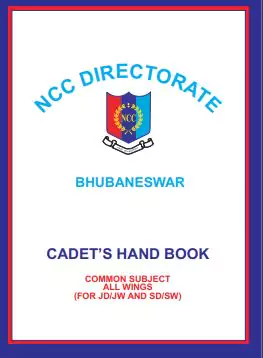‘NCC Cadet Hand Book’ PDF Quick download link is given at the bottom of this article. You can see the PDF demo, size of the PDF, page numbers, and direct download Free PDF of ‘NCC Cadet Hand Book‘ using the download button.
NCC Cadet Hand Book PDF Free Download

NCC Cadet Hand Book
GENERAL
Introduction 1. The National Cadet Corps (NCC) has its genesis in the ‘University Corps’, which was created under the Defence Act, of 1917 with the object to make up for the shortage of the Army. In 1920, when the Indian Territorial Act was passed, The `University Corps’ was replaced by the ‘University Training Corps (UTC)’ In 1942, the UTC was renamed the ‘University Officers Training Corps’ (UOTC).
The need to create a youth organisation at the National level to train young boys and girls to be better citizens and future leaders of our great country in all walks of life, including Defence forces, was rightly realized by our leaders.
A Committee under Pandit HN Kunzru was set up in 1946 at the behest of our first Prime Minister, Pandit Jawaharlal Nehru. The NCC came into existence on 16th July 1948 under the NCC Act XXXVI of 1948 under the Ministry of Defence (MOD).
NCC Motto 2. The Motto of the NCC is ‘Unity and Discipline which was adopted on 23 Dec 1957. In living up to its motto, the NCC strives to be and is one of the greatest cohesive forces of our nation, bringing together the youth hailing from different parts of our country and moulding them into united, secular and disciplined citizens of our nation.
Selection of NCC Flag 3. In 1954 the existing tricolour flag was introduced. The three colours in the flag depict the three Services of the Corps, red for the Army, deep blue for the Navy and light blue for the Air Force.
The letters NCC and the NCC crest in gold in the middle of the flag encircled by a wreath of lotus, give the flag a colourful look and a distinct identity. Each lotus represents one NCC Directorate (Date).
Aims 4. The aims of NCC as approved by MOD in Mar 2001 are as under:- (a) To develop character, comradeship, discipline, leadership, secular outlook, the spirit of adventure, sportsmanship and ideals of selfless service among the youth of the country.
(b) To create a human resource of organized, trained and motivated youth, to provide leadership in all walks of life and always be available for the service of the nation.
(c) To provide a suitable environment to motivate the youth to take up a career in the Armed Forces.
ORGANISATION
1. The NCC organization is administered through the MOD. The Defence Secretary is overall in-charge, who is responsible to the Govt, of India for the efficient functioning of the NCC and other matters.
2. The NCC is headed by the Director General (DG), an Army Officer of the rank of Lieutenant General, who is responsible for the functioning of the NCC in the country through the Dte Gen NCC situated at Delhi.
The DG at the Dte Gen NCC is assisted by two Additional Directors General (ADsG), one Major General from the Army and the other a Rear Admiral from the Navy or an Air Vice Marshal from the Air Force.
There are five Deputy Directors General (DDsG) of the rank of Brigadier and equivalent; three Brigadiers and one Commodore/Air Commodore and one civilian officer.
3. At the state level, the country has been divided into 17 Directorates (Dtes) covering all States and Union Territories. These Dtes are headed by an officer of the rank of Brigadier or its equivalent from the other two Services.
Each of the State NCC Dte controls two to fourteen Group Headquarters (Gp HQ), headed by an officer of the rank of Colonel or its equivalent. In all, there are 95 Gp HQs in the country, which exercise control over a network of 657 Army Wing Units (including Technical and Girls’ Unit), 59 Naval Wing Units and 58 Air Squadrons.
Details of NCC Dte’s and Gp HQs are given in Appendix ‘A’ & ‘B’ respectively. The NCC unit is commanded by a Lt Col/ Col (TS) or equivalent. In addition, the NCC has two training establishmentsOfficers Training School (OTS), Kamptee (near Nagpur) and Women Officers Training School (WOTS), Gwalior where professors and teachers from colleges and schools are specially trained to impart training to the cadets as Associate NCC Officers (ANOs).
| Author | NCC |
| Language | English |
| No. of Pages | 364 |
| PDF Size | 4.7 MB |
| Category | Education |
| Source/Credits | nccorissa.org |
NCC Cadet Hand Book PDF Free Download
